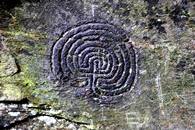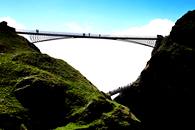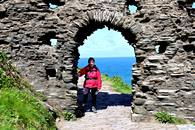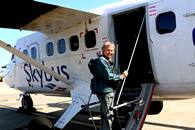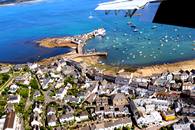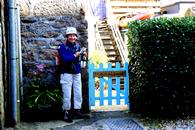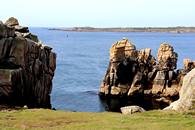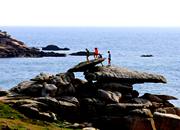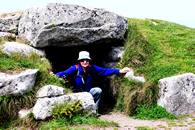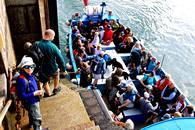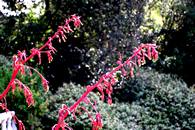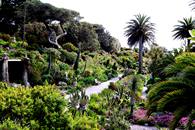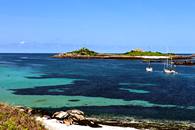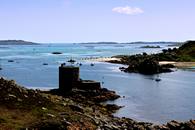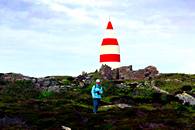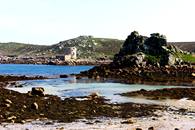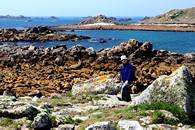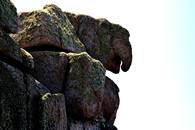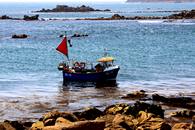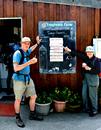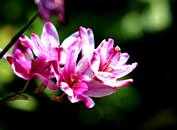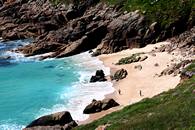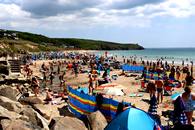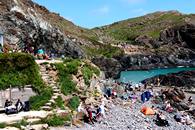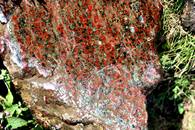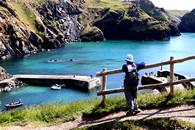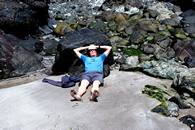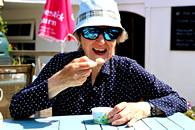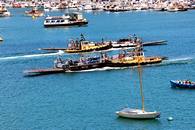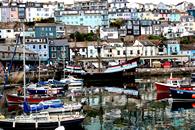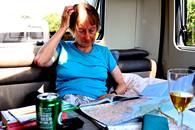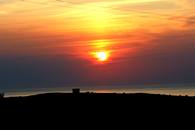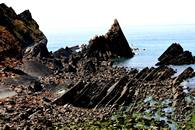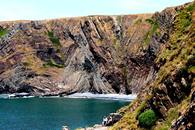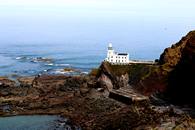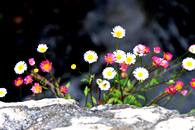
Chris and Sue in the Southwest, May-June 23.
Adey and Jan seemed to have thrown down a gauntlet, so to speak, so here are some pictures and text from our recent trip to the southwest. Far too many pics and locations to do the trip real justice, they will have to wait until later in the year in our Blurb book for 2023. However, here is a snippet of our trip, most of it on the Scillies but with other bits wrapped around it for completion.
1-5
Start of our huliday, we stayed for a few days at the rather expensive CAM site near Tintagel, well not that near, about a 2 mile hike actually. Below the campsite was Rocky Vally, so called because its full of rocks and had some rock carvings. These are the rather mysterious Labyrinthine Pattern carvings, purpose unknown but thought to date from the Bronze Age, some 1800 to 1400 BC.
As you do, we visited King Arthure's castle across Tintagel's new rip-off bridge. Had we not been members of English Heritage we would have been paying £20 each for the privelege and very little castle on the other side. Next day we took the bus to Crackington Haven just up the coast and walked back to the campsite via Boscastle along the coast path. We discovered that we were not all that coast-path-fit and the 10.5 miles and 850m of ascent caused us some hardship.
We moved to Trevedra Farm campsite which was only a couple of miles from Land's End airport, our taking off point for the Scillies. Handily, the campsite stored our campervan for the week that we were away. No campervans in the Scillies as they are rather lacking in roads. We took a taxi to the airport and took the 20 minute flight on a Twin Otter to St Mary's the largest of the islands. Land's End airport has the dubious reputation of being the world's most expensive airport. £121 single to St Mary's and no in-flight sandwiches. What! Picture 5 showns Hugh Town, the St Mary's capital from the air. Our self catering accommodation was just bottom right.
The Scillies is an archipeligo of five inhabited islands, silver sand beaches and rocky excrescences, the islands rise to a maximum of 51m and are situated 45km southwest of Cornwall. The main Islands are St Mary's, St Martin's, Tresco, Bryher and St Agnes. There are also dozens of uninhabited islands, lots of birds, rare plants and a famous lighthouse, Bishop's Rock. We visited the Scillies a few years ago in the autumn, and sailed there on the bumpy Scillonian III, an old rather flat bottomed boat which is due to be replaced by the spanking new Scillonian IV next year, new prices to be announced we suspect. Scillonian I was wrecked, Scillonian II was soon replaced by the current Scillonian III
The weather was sunny but with a cool easterly blowing most of the time.
6-10
We stayed at Dunmallard upper flat in Hugh Town St Mary's which was immaculate, it had wifi but no charging points otherwise hard to fault other than it being quite expensive, £750 for the week. We circumnavigated St Mary's which was about 8.5 miles and noted several rocky sections around the south and west sides, there must be climbing here. St Mary's has lots of Entrance Graves and ancient stones, many which date back to the Neolithic period. Next day we took the ferry from the Quay at Hugh Town to Tresco. These little ferries run every day to the various islands. Typical cost, about £13 return.
11-15
The Abbey gardens at Tresco were magnificent, and we reckoned that they were the best gardens that we had ever visited, and we've visited quite a few over the years. After the gardens we visited its tea room, then we circumnavigated the island which was very beautiful, with lots of skerries and bottom-ripping rocks as far as the eye could see. We also located the rare Sea Dock which was less impressive. Pic 15 is Cromwell's Castle on the east side of Tresco, below the older King Charles castle which was actually build by Edward VI. It was eventually blown up by Royalists at the end of the English Civil War in 1651. Cromwell's castle, a tall round tower, stands on a low projecting shelf of rock, is one of only a few stone fortifications that survive from the Interregnum (1649–60). It takes its name from Oliver Cromwell, Lord Protector of England.
16-20
Our next island to circumnavigate was St Martin's. An irregularly shaped affair with a complex of islands on its north end, and a bold red and white striped navigation beacon at its east end. Next day we visited the small island of Bryher which is actually joined to Tresco at very low tide. Pic 16 the St Martin's navigation beacon, pic 17 Cromwell's castle from the island of Bryher, rocks and skerries, Droppinose Point and a lobster boat. There were quite a few climeable granite tors on Bryher though the rock was cruelly rough with large crystals of feldspa..
21,22
Last Island, on the Scillies, we took the ferry to St Agnes which is the most southerly inhabited island of the archipeligo. The Island is joined to its smaller uninhabited brother, Gugh by a sand spit which is covered at high tide, so don't get cut off and miss the return ferry! St Agnes was quite popular with camping groups though it was hardly a problem. On a plus side there was a pub at the ferry slipway and the local farm sold G&T flavoured ice creams. Pic 21 G&T flavoured ice cream, pic 22 the rare Red Corn Lily.
23-25
On our return to Cornwall we spent a few more days at Trevedra before heading off on our travels. Pic 23 Just another secluded Cornish beach. Heaven or hell? Praa sands and Keynance Cove during the bank holiday week.
26-30
We stayed near Marazion and visited St Michels Mount where the gardens were pretty spectacular, pic 28 is Serpentine, made famous by Queen Victoria, there's lots of this near the Lizard, pic 29 Sue checks out Mullion Cove, pic 30, it's all been a bit much.
31-34
Just another ice cream stop, Pic 32 damn, sold out, Pic 33 Good selection of gins down here, decisions decisions, Dartmouth the ferries here are pushed across the estuary by tugs.
35-39
Pic 36, Brixton harbour and the Golden Hind replica museum ship. Feeling ambitious, from our campsite near Dartmouth, we took the bus to the harbour, crossed the estuary at lower ferry to Kingswear then took a bus to Brixton where we planned to walk back along the coast path to Kingswear. This was the first of the very hot days with no breeze and temperatures nudging 30 degrees. On the map it looked standard fare, and we made slight deviations (we were lost) to check out Berry Head and fortifications then pressed on regardless along the SW coast path towards Kingswear. All did not go too well and the heat and we were soon flagging, the 850m of ascent and the 12.5 miles all conspired to make this a challenging day out. Once across the ferry, we caught the bus by the skin of our teeth. Next day, somwhat battered we took a pleasant stroll along the Dart Valley Trail to Agatha Christie's place at Greenway, checked it out and visited the NT cafe, then took a leisurely ferry back to Dartmouth.
We pointed the campervan north and headed for the Hartland peninsula, one of my favourite coastal areas. We stayed at the pleasant Stoke Barton Farm campsite which was about a mile from the coast close to Hartland Quay where there is a fine pub. Pic 36 says I think that we were lost, sunset from Stoke Barton Farm, Culm coast, rock folds from Hartland Quay. Pic 40, Speke's Mill waterfall. pic 41 Hartland Point lighthouse.
40-43
Last few days, we moved to Lynton and walked along the cliffs round Foreland point untill, dogged by exhaustion and mauled by ticks and pollen we cut across country into the delightful Watersmeet valley, dropped in at the very welcome NT cafe then and back to out site at Lyn Bridge.
Mexican Fleabanes were everywhere.,
Take me away from all this!
FAO John Middleton.
- Mangrove-leaved Daisy Bush Oliaria avicennifolia *
- Treasure Flower Gazania rigins *
- Balm Leaved Figwort Scrophularia scrodonia *
- Orange Birdsfoot Ornithopus pinnatus *
- Red Corn Lily Ixia campanulata *
- Blue Corn Lily Aristea ecklonii *
- Fleshy Yellow Sorrel Oxalis rubrocincta *
- Wire Vine Muehlenbeckia axillaris *
- Karo Pittosporum crassifolium *
- Pastel de Risco Aeonium tabuliforme *
- Giant Herb Robert Geranium maderense *
- Tree Bedstraw Coprosna repens *
- Shore Dock Rumex rupestris *
- Giant Echium Echium pininana
- Subterranean Clover Trifolium subterraneanum
- Rough Clover Trifolium scabrum
- Western CloverTrifolium occidentale
- Rosy Garlic Allium roseum
- Chilean Iris Libertia formosa
- Small Flowered Catchfly Silene gallica
- Yellow Centaury Cicendia filiformis
- Green-winged orchid Anacamptis morio
- Fringed Rupturewort Herniaria ciliolata
* Identified on The Scillies
Now onward goes, along a narrow path
Between the torments and the city wall,
My Master, and I follow at his back.
Dante's Inferno, Canto 10
Chris Jackson email
